Pearson BTEC Level 5 HND Diploma in Business: Business Contract Law
VerifiedAdded on 2019/09/26
|11
|3087
|164
Report
AI Summary
This assignment is a comprehensive report on business contract law, covering the essential elements of a valid contract, different types of contracts, and their practical application in various business scenarios. It delves into offer, acceptance, intention, and consideration, and includes case studies to illustrate contract formation and breach. The report also examines the law of negligence, its application in business activities, and the differences between contract and tort liabilities. It analyzes express and implied terms, exclusion clauses, and principles of vicarious liability. Additionally, the assignment addresses the concept of promissory estoppel and strict liability, providing a detailed understanding of contract and negligence in a business context. The report incorporates the provided scenarios to analyze the validity of contracts and assess liability in negligence cases, offering a thorough analysis of legal principles and their practical implications.
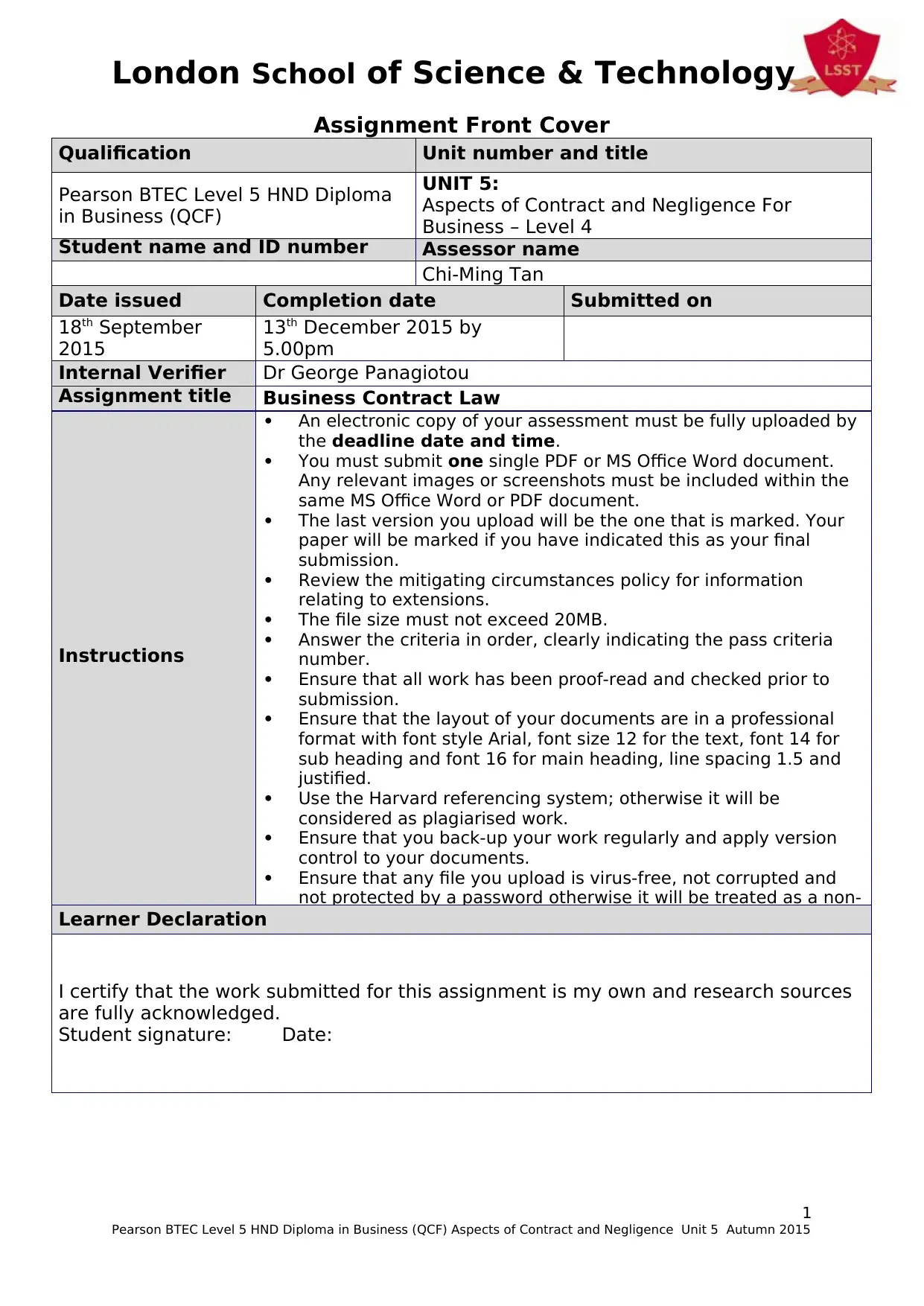
London School of Science & Technology
Assignment Front Cover
Qualification Unit number and title
Pearson BTEC Level 5 HND Diploma
in Business (QCF)
UNIT 5:
Aspects of Contract and Negligence For
Business – Level 4
Student name and ID number Assessor name
Chi-Ming Tan
Date issued Completion date Submitted on
18th September
2015
13th December 2015 by
5.00pm
Internal Verifier Dr George Panagiotou
Assignment title Business Contract Law
Instructions
An electronic copy of your assessment must be fully uploaded by
the deadline date and time.
You must submit one single PDF or MS Office Word document.
Any relevant images or screenshots must be included within the
same MS Office Word or PDF document.
The last version you upload will be the one that is marked. Your
paper will be marked if you have indicated this as your final
submission.
Review the mitigating circumstances policy for information
relating to extensions.
The file size must not exceed 20MB.
Answer the criteria in order, clearly indicating the pass criteria
number.
Ensure that all work has been proof-read and checked prior to
submission.
Ensure that the layout of your documents are in a professional
format with font style Arial, font size 12 for the text, font 14 for
sub heading and font 16 for main heading, line spacing 1.5 and
justified.
Use the Harvard referencing system; otherwise it will be
considered as plagiarised work.
Ensure that you back-up your work regularly and apply version
control to your documents.
Ensure that any file you upload is virus-free, not corrupted and
not protected by a password otherwise it will be treated as a non-
Learner Declaration
I certify that the work submitted for this assignment is my own and research sources
are fully acknowledged.
Student signature: Date:
1
Pearson BTEC Level 5 HND Diploma in Business (QCF) Aspects of Contract and Negligence Unit 5 Autumn 2015
Assignment Front Cover
Qualification Unit number and title
Pearson BTEC Level 5 HND Diploma
in Business (QCF)
UNIT 5:
Aspects of Contract and Negligence For
Business – Level 4
Student name and ID number Assessor name
Chi-Ming Tan
Date issued Completion date Submitted on
18th September
2015
13th December 2015 by
5.00pm
Internal Verifier Dr George Panagiotou
Assignment title Business Contract Law
Instructions
An electronic copy of your assessment must be fully uploaded by
the deadline date and time.
You must submit one single PDF or MS Office Word document.
Any relevant images or screenshots must be included within the
same MS Office Word or PDF document.
The last version you upload will be the one that is marked. Your
paper will be marked if you have indicated this as your final
submission.
Review the mitigating circumstances policy for information
relating to extensions.
The file size must not exceed 20MB.
Answer the criteria in order, clearly indicating the pass criteria
number.
Ensure that all work has been proof-read and checked prior to
submission.
Ensure that the layout of your documents are in a professional
format with font style Arial, font size 12 for the text, font 14 for
sub heading and font 16 for main heading, line spacing 1.5 and
justified.
Use the Harvard referencing system; otherwise it will be
considered as plagiarised work.
Ensure that you back-up your work regularly and apply version
control to your documents.
Ensure that any file you upload is virus-free, not corrupted and
not protected by a password otherwise it will be treated as a non-
Learner Declaration
I certify that the work submitted for this assignment is my own and research sources
are fully acknowledged.
Student signature: Date:
1
Pearson BTEC Level 5 HND Diploma in Business (QCF) Aspects of Contract and Negligence Unit 5 Autumn 2015
Paraphrase This Document
Need a fresh take? Get an instant paraphrase of this document with our AI Paraphraser
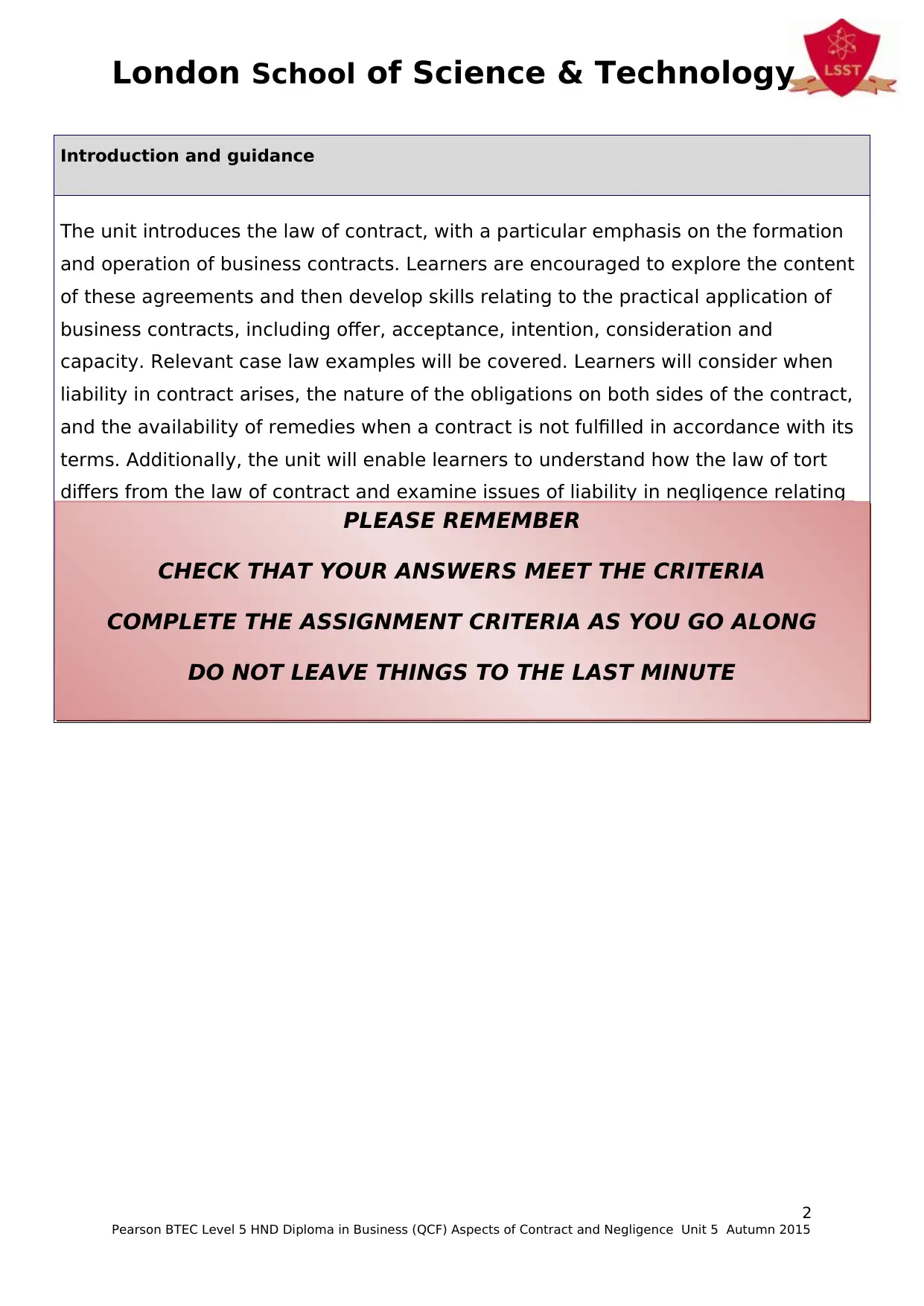
London School of Science & Technology
Introduction and guidance
The unit introduces the law of contract, with a particular emphasis on the formation
and operation of business contracts. Learners are encouraged to explore the content
of these agreements and then develop skills relating to the practical application of
business contracts, including offer, acceptance, intention, consideration and
capacity. Relevant case law examples will be covered. Learners will consider when
liability in contract arises, the nature of the obligations on both sides of the contract,
and the availability of remedies when a contract is not fulfilled in accordance with its
terms. Additionally, the unit will enable learners to understand how the law of tort
differs from the law of contract and examine issues of liability in negligence relating
to business and how to avoid it.
2
Pearson BTEC Level 5 HND Diploma in Business (QCF) Aspects of Contract and Negligence Unit 5 Autumn 2015
PLEASE REMEMBER
CHECK THAT YOUR ANSWERS MEET THE CRITERIA
COMPLETE THE ASSIGNMENT CRITERIA AS YOU GO ALONG
DO NOT LEAVE THINGS TO THE LAST MINUTE
Introduction and guidance
The unit introduces the law of contract, with a particular emphasis on the formation
and operation of business contracts. Learners are encouraged to explore the content
of these agreements and then develop skills relating to the practical application of
business contracts, including offer, acceptance, intention, consideration and
capacity. Relevant case law examples will be covered. Learners will consider when
liability in contract arises, the nature of the obligations on both sides of the contract,
and the availability of remedies when a contract is not fulfilled in accordance with its
terms. Additionally, the unit will enable learners to understand how the law of tort
differs from the law of contract and examine issues of liability in negligence relating
to business and how to avoid it.
2
Pearson BTEC Level 5 HND Diploma in Business (QCF) Aspects of Contract and Negligence Unit 5 Autumn 2015
PLEASE REMEMBER
CHECK THAT YOUR ANSWERS MEET THE CRITERIA
COMPLETE THE ASSIGNMENT CRITERIA AS YOU GO ALONG
DO NOT LEAVE THINGS TO THE LAST MINUTE
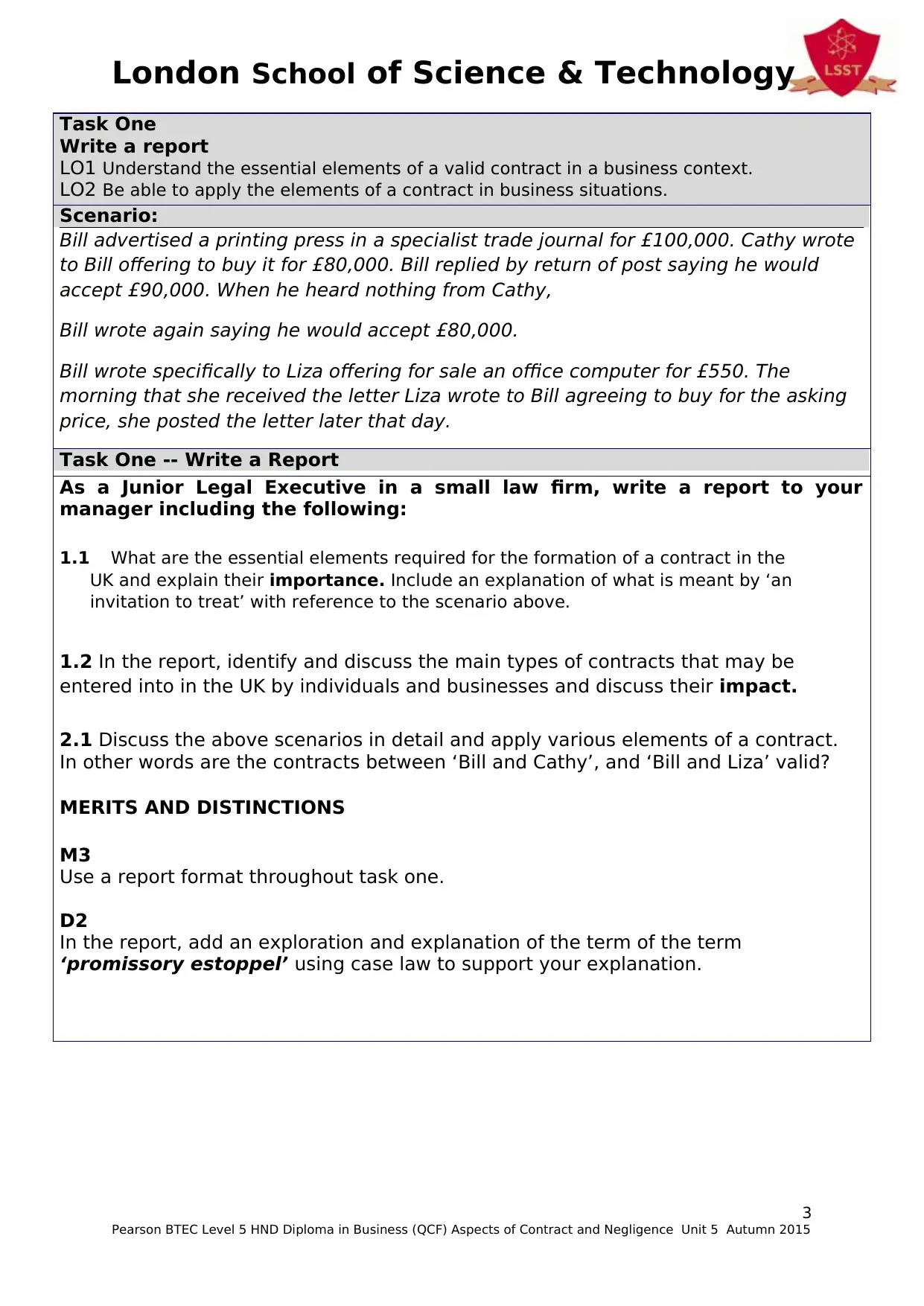
London School of Science & Technology
Task One
Write a report
LO1 Understand the essential elements of a valid contract in a business context.
LO2 Be able to apply the elements of a contract in business situations.
Scenario:
Bill advertised a printing press in a specialist trade journal for £100,000. Cathy wrote
to Bill offering to buy it for £80,000. Bill replied by return of post saying he would
accept £90,000. When he heard nothing from Cathy,
Bill wrote again saying he would accept £80,000.
Bill wrote specifically to Liza offering for sale an office computer for £550. The
morning that she received the letter Liza wrote to Bill agreeing to buy for the asking
price, she posted the letter later that day.
Task One -- Write a Report
As a Junior Legal Executive in a small law firm, write a report to your
manager including the following:
1.1 What are the essential elements required for the formation of a contract in the
UK and explain their importance. Include an explanation of what is meant by ‘an
invitation to treat’ with reference to the scenario above.
1.2 In the report, identify and discuss the main types of contracts that may be
entered into in the UK by individuals and businesses and discuss their impact.
2.1 Discuss the above scenarios in detail and apply various elements of a contract.
In other words are the contracts between ‘Bill and Cathy’, and ‘Bill and Liza’ valid?
MERITS AND DISTINCTIONS
M3
Use a report format throughout task one.
D2
In the report, add an exploration and explanation of the term of the term
‘promissory estoppel’ using case law to support your explanation.
3
Pearson BTEC Level 5 HND Diploma in Business (QCF) Aspects of Contract and Negligence Unit 5 Autumn 2015
Task One
Write a report
LO1 Understand the essential elements of a valid contract in a business context.
LO2 Be able to apply the elements of a contract in business situations.
Scenario:
Bill advertised a printing press in a specialist trade journal for £100,000. Cathy wrote
to Bill offering to buy it for £80,000. Bill replied by return of post saying he would
accept £90,000. When he heard nothing from Cathy,
Bill wrote again saying he would accept £80,000.
Bill wrote specifically to Liza offering for sale an office computer for £550. The
morning that she received the letter Liza wrote to Bill agreeing to buy for the asking
price, she posted the letter later that day.
Task One -- Write a Report
As a Junior Legal Executive in a small law firm, write a report to your
manager including the following:
1.1 What are the essential elements required for the formation of a contract in the
UK and explain their importance. Include an explanation of what is meant by ‘an
invitation to treat’ with reference to the scenario above.
1.2 In the report, identify and discuss the main types of contracts that may be
entered into in the UK by individuals and businesses and discuss their impact.
2.1 Discuss the above scenarios in detail and apply various elements of a contract.
In other words are the contracts between ‘Bill and Cathy’, and ‘Bill and Liza’ valid?
MERITS AND DISTINCTIONS
M3
Use a report format throughout task one.
D2
In the report, add an exploration and explanation of the term of the term
‘promissory estoppel’ using case law to support your explanation.
3
Pearson BTEC Level 5 HND Diploma in Business (QCF) Aspects of Contract and Negligence Unit 5 Autumn 2015
⊘ This is a preview!⊘
Do you want full access?
Subscribe today to unlock all pages.

Trusted by 1+ million students worldwide
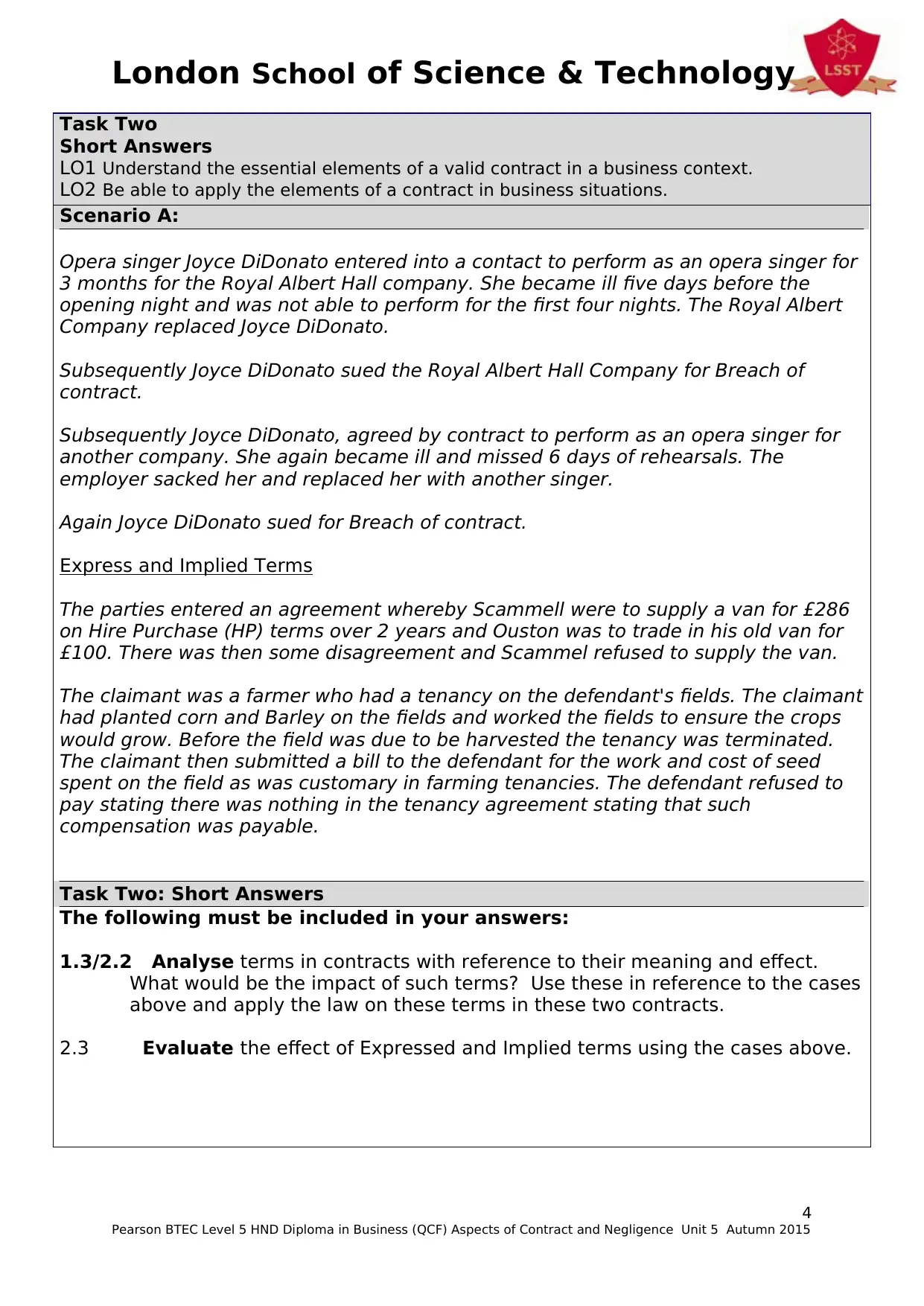
London School of Science & Technology
Task Two
Short Answers
LO1 Understand the essential elements of a valid contract in a business context.
LO2 Be able to apply the elements of a contract in business situations.
Scenario A:
Opera singer Joyce DiDonato entered into a contact to perform as an opera singer for
3 months for the Royal Albert Hall company. She became ill five days before the
opening night and was not able to perform for the first four nights. The Royal Albert
Company replaced Joyce DiDonato.
Subsequently Joyce DiDonato sued the Royal Albert Hall Company for Breach of
contract.
Subsequently Joyce DiDonato, agreed by contract to perform as an opera singer for
another company. She again became ill and missed 6 days of rehearsals. The
employer sacked her and replaced her with another singer.
Again Joyce DiDonato sued for Breach of contract.
Express and Implied Terms
The parties entered an agreement whereby Scammell were to supply a van for £286
on Hire Purchase (HP) terms over 2 years and Ouston was to trade in his old van for
£100. There was then some disagreement and Scammel refused to supply the van.
The claimant was a farmer who had a tenancy on the defendant's fields. The claimant
had planted corn and Barley on the fields and worked the fields to ensure the crops
would grow. Before the field was due to be harvested the tenancy was terminated.
The claimant then submitted a bill to the defendant for the work and cost of seed
spent on the field as was customary in farming tenancies. The defendant refused to
pay stating there was nothing in the tenancy agreement stating that such
compensation was payable.
Task Two: Short Answers
The following must be included in your answers:
1.3/2.2 Analyse terms in contracts with reference to their meaning and effect.
What would be the impact of such terms? Use these in reference to the cases
above and apply the law on these terms in these two contracts.
2.3 Evaluate the effect of Expressed and Implied terms using the cases above.
4
Pearson BTEC Level 5 HND Diploma in Business (QCF) Aspects of Contract and Negligence Unit 5 Autumn 2015
Task Two
Short Answers
LO1 Understand the essential elements of a valid contract in a business context.
LO2 Be able to apply the elements of a contract in business situations.
Scenario A:
Opera singer Joyce DiDonato entered into a contact to perform as an opera singer for
3 months for the Royal Albert Hall company. She became ill five days before the
opening night and was not able to perform for the first four nights. The Royal Albert
Company replaced Joyce DiDonato.
Subsequently Joyce DiDonato sued the Royal Albert Hall Company for Breach of
contract.
Subsequently Joyce DiDonato, agreed by contract to perform as an opera singer for
another company. She again became ill and missed 6 days of rehearsals. The
employer sacked her and replaced her with another singer.
Again Joyce DiDonato sued for Breach of contract.
Express and Implied Terms
The parties entered an agreement whereby Scammell were to supply a van for £286
on Hire Purchase (HP) terms over 2 years and Ouston was to trade in his old van for
£100. There was then some disagreement and Scammel refused to supply the van.
The claimant was a farmer who had a tenancy on the defendant's fields. The claimant
had planted corn and Barley on the fields and worked the fields to ensure the crops
would grow. Before the field was due to be harvested the tenancy was terminated.
The claimant then submitted a bill to the defendant for the work and cost of seed
spent on the field as was customary in farming tenancies. The defendant refused to
pay stating there was nothing in the tenancy agreement stating that such
compensation was payable.
Task Two: Short Answers
The following must be included in your answers:
1.3/2.2 Analyse terms in contracts with reference to their meaning and effect.
What would be the impact of such terms? Use these in reference to the cases
above and apply the law on these terms in these two contracts.
2.3 Evaluate the effect of Expressed and Implied terms using the cases above.
4
Pearson BTEC Level 5 HND Diploma in Business (QCF) Aspects of Contract and Negligence Unit 5 Autumn 2015
Paraphrase This Document
Need a fresh take? Get an instant paraphrase of this document with our AI Paraphraser
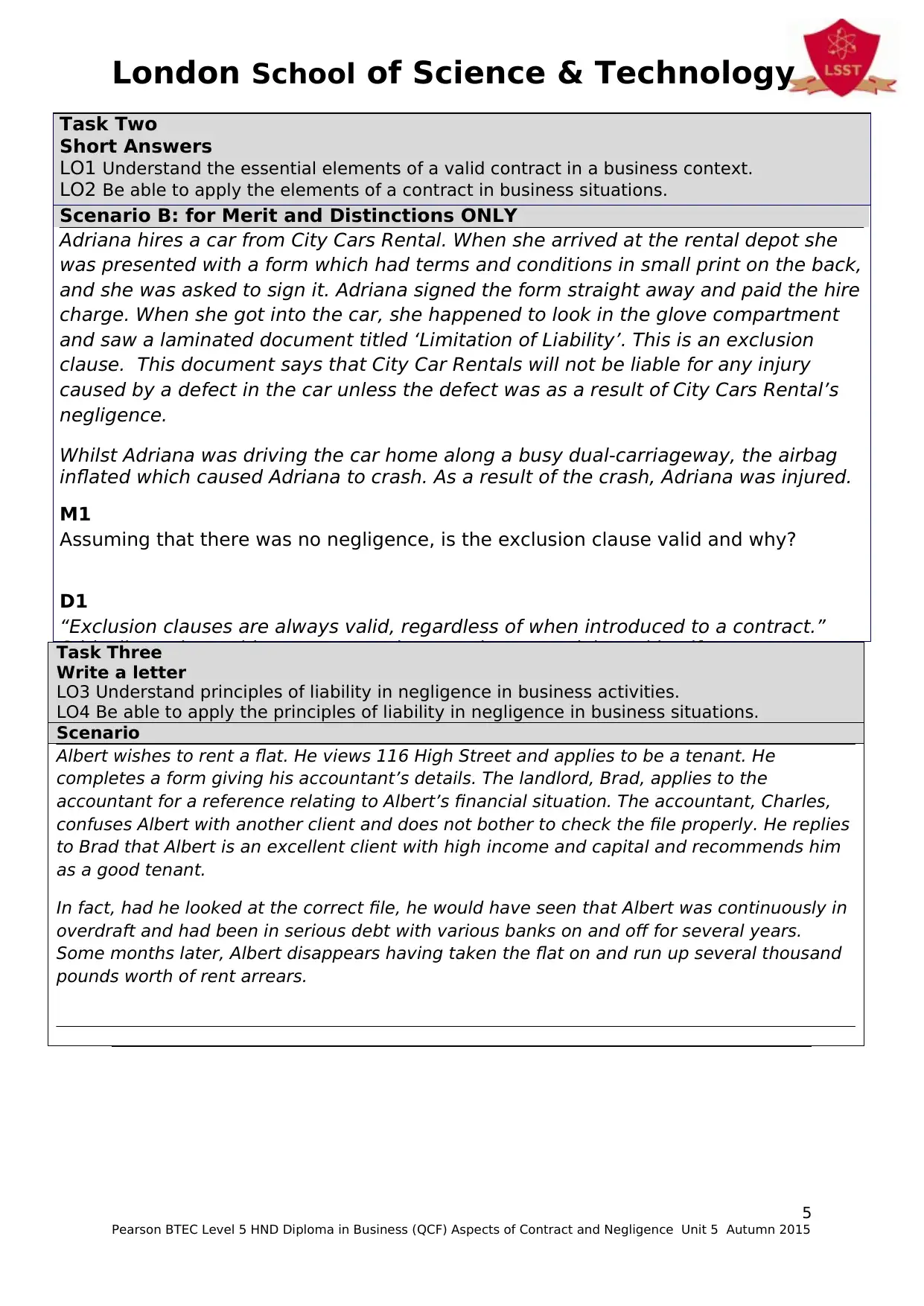
London School of Science & Technology
Task Two
Short Answers
LO1 Understand the essential elements of a valid contract in a business context.
LO2 Be able to apply the elements of a contract in business situations.
Scenario B: for Merit and Distinctions ONLY
Adriana hires a car from City Cars Rental. When she arrived at the rental depot she
was presented with a form which had terms and conditions in small print on the back,
and she was asked to sign it. Adriana signed the form straight away and paid the hire
charge. When she got into the car, she happened to look in the glove compartment
and saw a laminated document titled ‘Limitation of Liability’. This is an exclusion
clause. This document says that City Car Rentals will not be liable for any injury
caused by a defect in the car unless the defect was as a result of City Cars Rental’s
negligence.
Whilst Adriana was driving the car home along a busy dual-carriageway, the airbag
inflated which caused Adriana to crash. As a result of the crash, Adriana was injured.
M1
Assuming that there was no negligence, is the exclusion clause valid and why?
D1
“Exclusion clauses are always valid, regardless of when introduced to a contract.”
Critically evaluate this statement using case law to explain and justify your answer.Task Three
Write a letter
LO3 Understand principles of liability in negligence in business activities.
LO4 Be able to apply the principles of liability in negligence in business situations.
Scenario
Albert wishes to rent a flat. He views 116 High Street and applies to be a tenant. He
completes a form giving his accountant’s details. The landlord, Brad, applies to the
accountant for a reference relating to Albert’s financial situation. The accountant, Charles,
confuses Albert with another client and does not bother to check the file properly. He replies
to Brad that Albert is an excellent client with high income and capital and recommends him
as a good tenant.
In fact, had he looked at the correct file, he would have seen that Albert was continuously in
overdraft and had been in serious debt with various banks on and off for several years.
Some months later, Albert disappears having taken the flat on and run up several thousand
pounds worth of rent arrears.
5
Pearson BTEC Level 5 HND Diploma in Business (QCF) Aspects of Contract and Negligence Unit 5 Autumn 2015
Task Two
Short Answers
LO1 Understand the essential elements of a valid contract in a business context.
LO2 Be able to apply the elements of a contract in business situations.
Scenario B: for Merit and Distinctions ONLY
Adriana hires a car from City Cars Rental. When she arrived at the rental depot she
was presented with a form which had terms and conditions in small print on the back,
and she was asked to sign it. Adriana signed the form straight away and paid the hire
charge. When she got into the car, she happened to look in the glove compartment
and saw a laminated document titled ‘Limitation of Liability’. This is an exclusion
clause. This document says that City Car Rentals will not be liable for any injury
caused by a defect in the car unless the defect was as a result of City Cars Rental’s
negligence.
Whilst Adriana was driving the car home along a busy dual-carriageway, the airbag
inflated which caused Adriana to crash. As a result of the crash, Adriana was injured.
M1
Assuming that there was no negligence, is the exclusion clause valid and why?
D1
“Exclusion clauses are always valid, regardless of when introduced to a contract.”
Critically evaluate this statement using case law to explain and justify your answer.Task Three
Write a letter
LO3 Understand principles of liability in negligence in business activities.
LO4 Be able to apply the principles of liability in negligence in business situations.
Scenario
Albert wishes to rent a flat. He views 116 High Street and applies to be a tenant. He
completes a form giving his accountant’s details. The landlord, Brad, applies to the
accountant for a reference relating to Albert’s financial situation. The accountant, Charles,
confuses Albert with another client and does not bother to check the file properly. He replies
to Brad that Albert is an excellent client with high income and capital and recommends him
as a good tenant.
In fact, had he looked at the correct file, he would have seen that Albert was continuously in
overdraft and had been in serious debt with various banks on and off for several years.
Some months later, Albert disappears having taken the flat on and run up several thousand
pounds worth of rent arrears.
5
Pearson BTEC Level 5 HND Diploma in Business (QCF) Aspects of Contract and Negligence Unit 5 Autumn 2015
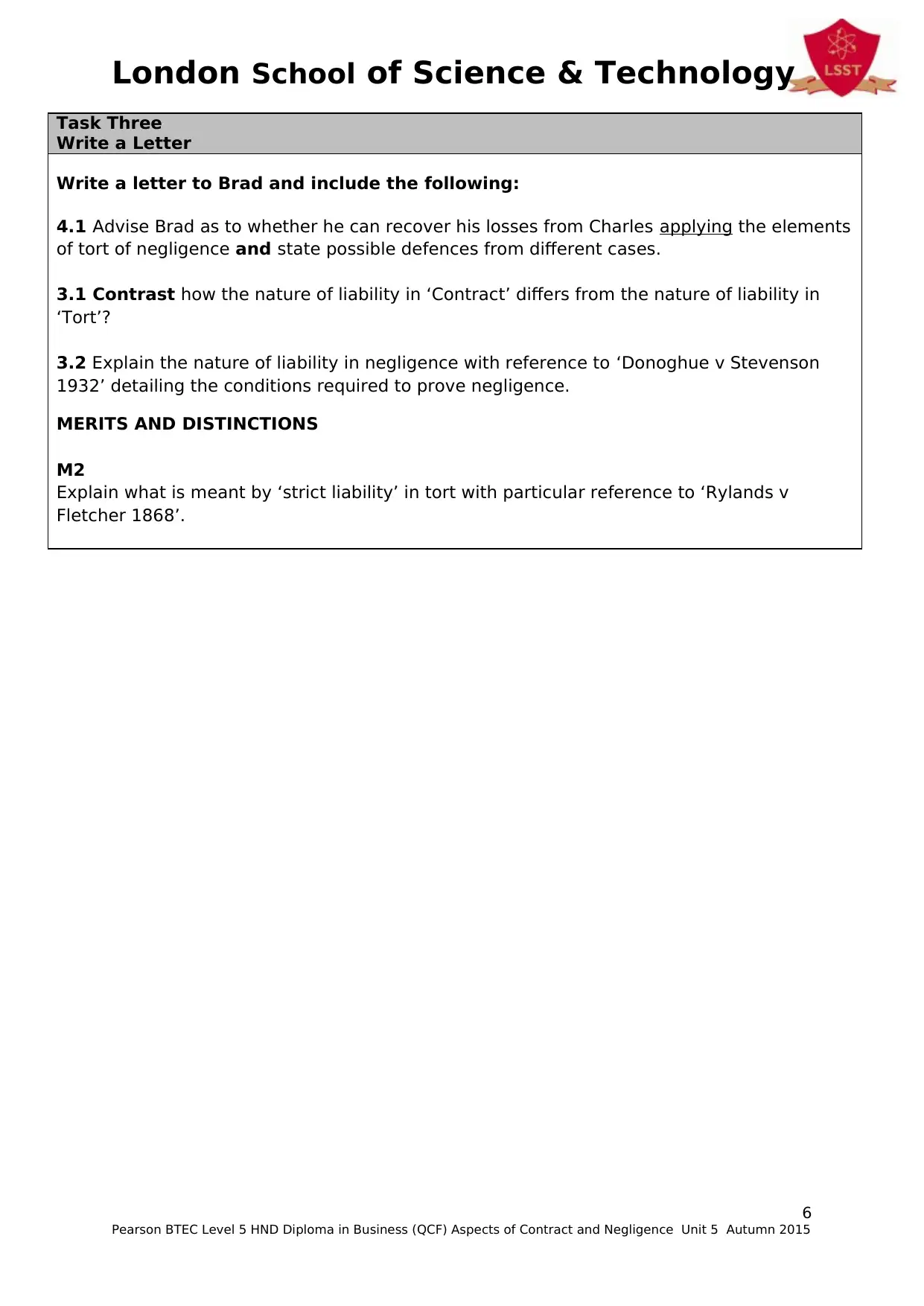
London School of Science & Technology
Task Three
Write a Letter
Write a letter to Brad and include the following:
4.1 Advise Brad as to whether he can recover his losses from Charles applying the elements
of tort of negligence and state possible defences from different cases.
3.1 Contrast how the nature of liability in ‘Contract’ differs from the nature of liability in
‘Tort’?
3.2 Explain the nature of liability in negligence with reference to ‘Donoghue v Stevenson
1932’ detailing the conditions required to prove negligence.
MERITS AND DISTINCTIONS
M2
Explain what is meant by ‘strict liability’ in tort with particular reference to ‘Rylands v
Fletcher 1868’.
6
Pearson BTEC Level 5 HND Diploma in Business (QCF) Aspects of Contract and Negligence Unit 5 Autumn 2015
Task Three
Write a Letter
Write a letter to Brad and include the following:
4.1 Advise Brad as to whether he can recover his losses from Charles applying the elements
of tort of negligence and state possible defences from different cases.
3.1 Contrast how the nature of liability in ‘Contract’ differs from the nature of liability in
‘Tort’?
3.2 Explain the nature of liability in negligence with reference to ‘Donoghue v Stevenson
1932’ detailing the conditions required to prove negligence.
MERITS AND DISTINCTIONS
M2
Explain what is meant by ‘strict liability’ in tort with particular reference to ‘Rylands v
Fletcher 1868’.
6
Pearson BTEC Level 5 HND Diploma in Business (QCF) Aspects of Contract and Negligence Unit 5 Autumn 2015
⊘ This is a preview!⊘
Do you want full access?
Subscribe today to unlock all pages.

Trusted by 1+ million students worldwide
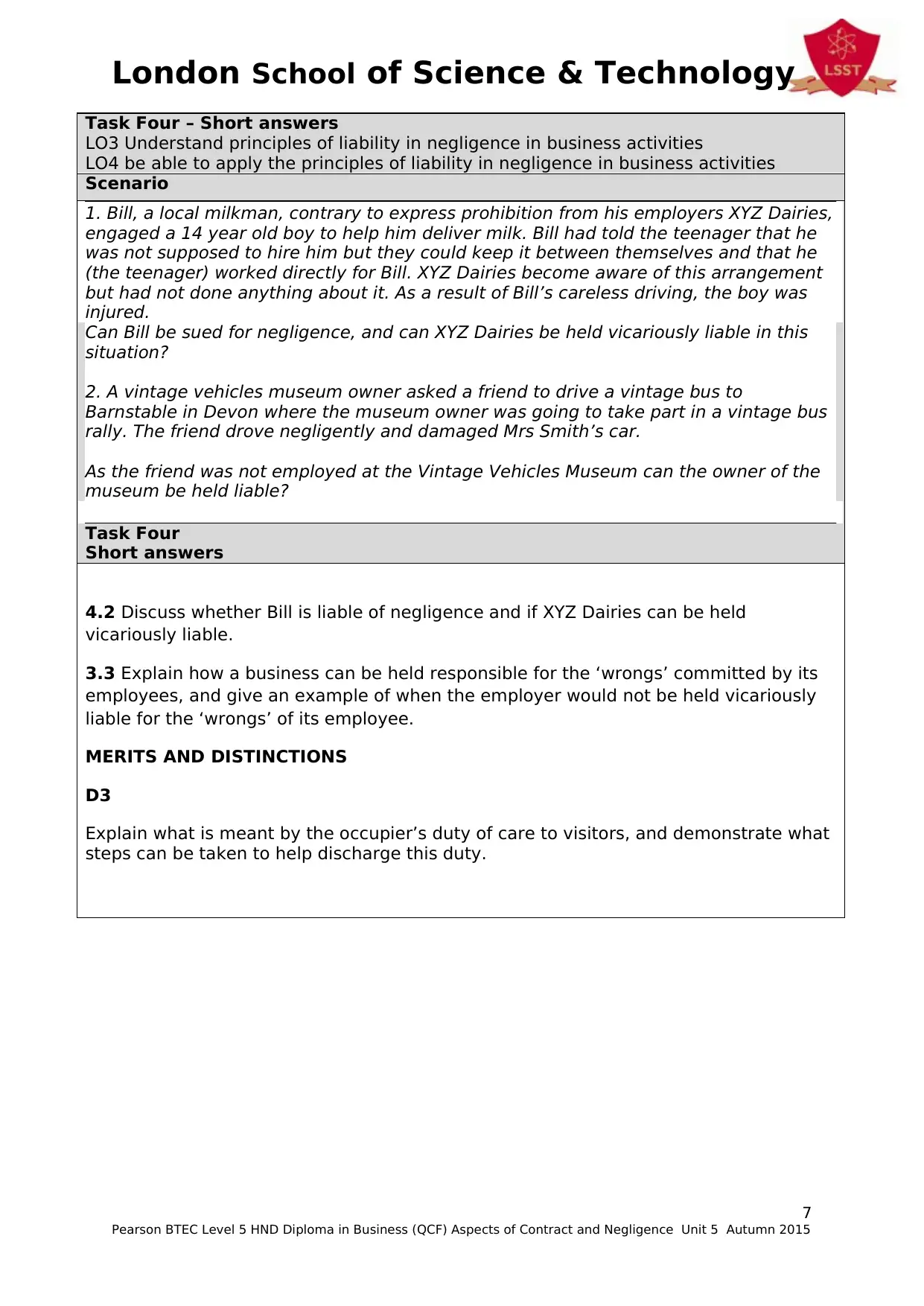
London School of Science & Technology
Task Four – Short answers
LO3 Understand principles of liability in negligence in business activities
LO4 be able to apply the principles of liability in negligence in business activities
Scenario
1. Bill, a local milkman, contrary to express prohibition from his employers XYZ Dairies,
engaged a 14 year old boy to help him deliver milk. Bill had told the teenager that he
was not supposed to hire him but they could keep it between themselves and that he
(the teenager) worked directly for Bill. XYZ Dairies become aware of this arrangement
but had not done anything about it. As a result of Bill’s careless driving, the boy was
injured.
Can Bill be sued for negligence, and can XYZ Dairies be held vicariously liable in this
situation?
2. A vintage vehicles museum owner asked a friend to drive a vintage bus to
Barnstable in Devon where the museum owner was going to take part in a vintage bus
rally. The friend drove negligently and damaged Mrs Smith’s car.
As the friend was not employed at the Vintage Vehicles Museum can the owner of the
museum be held liable?
Task Four
Short answers
4.2 Discuss whether Bill is liable of negligence and if XYZ Dairies can be held
vicariously liable.
3.3 Explain how a business can be held responsible for the ‘wrongs’ committed by its
employees, and give an example of when the employer would not be held vicariously
liable for the ‘wrongs’ of its employee.
MERITS AND DISTINCTIONS
D3
Explain what is meant by the occupier’s duty of care to visitors, and demonstrate what
steps can be taken to help discharge this duty.
7
Pearson BTEC Level 5 HND Diploma in Business (QCF) Aspects of Contract and Negligence Unit 5 Autumn 2015
Task Four – Short answers
LO3 Understand principles of liability in negligence in business activities
LO4 be able to apply the principles of liability in negligence in business activities
Scenario
1. Bill, a local milkman, contrary to express prohibition from his employers XYZ Dairies,
engaged a 14 year old boy to help him deliver milk. Bill had told the teenager that he
was not supposed to hire him but they could keep it between themselves and that he
(the teenager) worked directly for Bill. XYZ Dairies become aware of this arrangement
but had not done anything about it. As a result of Bill’s careless driving, the boy was
injured.
Can Bill be sued for negligence, and can XYZ Dairies be held vicariously liable in this
situation?
2. A vintage vehicles museum owner asked a friend to drive a vintage bus to
Barnstable in Devon where the museum owner was going to take part in a vintage bus
rally. The friend drove negligently and damaged Mrs Smith’s car.
As the friend was not employed at the Vintage Vehicles Museum can the owner of the
museum be held liable?
Task Four
Short answers
4.2 Discuss whether Bill is liable of negligence and if XYZ Dairies can be held
vicariously liable.
3.3 Explain how a business can be held responsible for the ‘wrongs’ committed by its
employees, and give an example of when the employer would not be held vicariously
liable for the ‘wrongs’ of its employee.
MERITS AND DISTINCTIONS
D3
Explain what is meant by the occupier’s duty of care to visitors, and demonstrate what
steps can be taken to help discharge this duty.
7
Pearson BTEC Level 5 HND Diploma in Business (QCF) Aspects of Contract and Negligence Unit 5 Autumn 2015
Paraphrase This Document
Need a fresh take? Get an instant paraphrase of this document with our AI Paraphraser
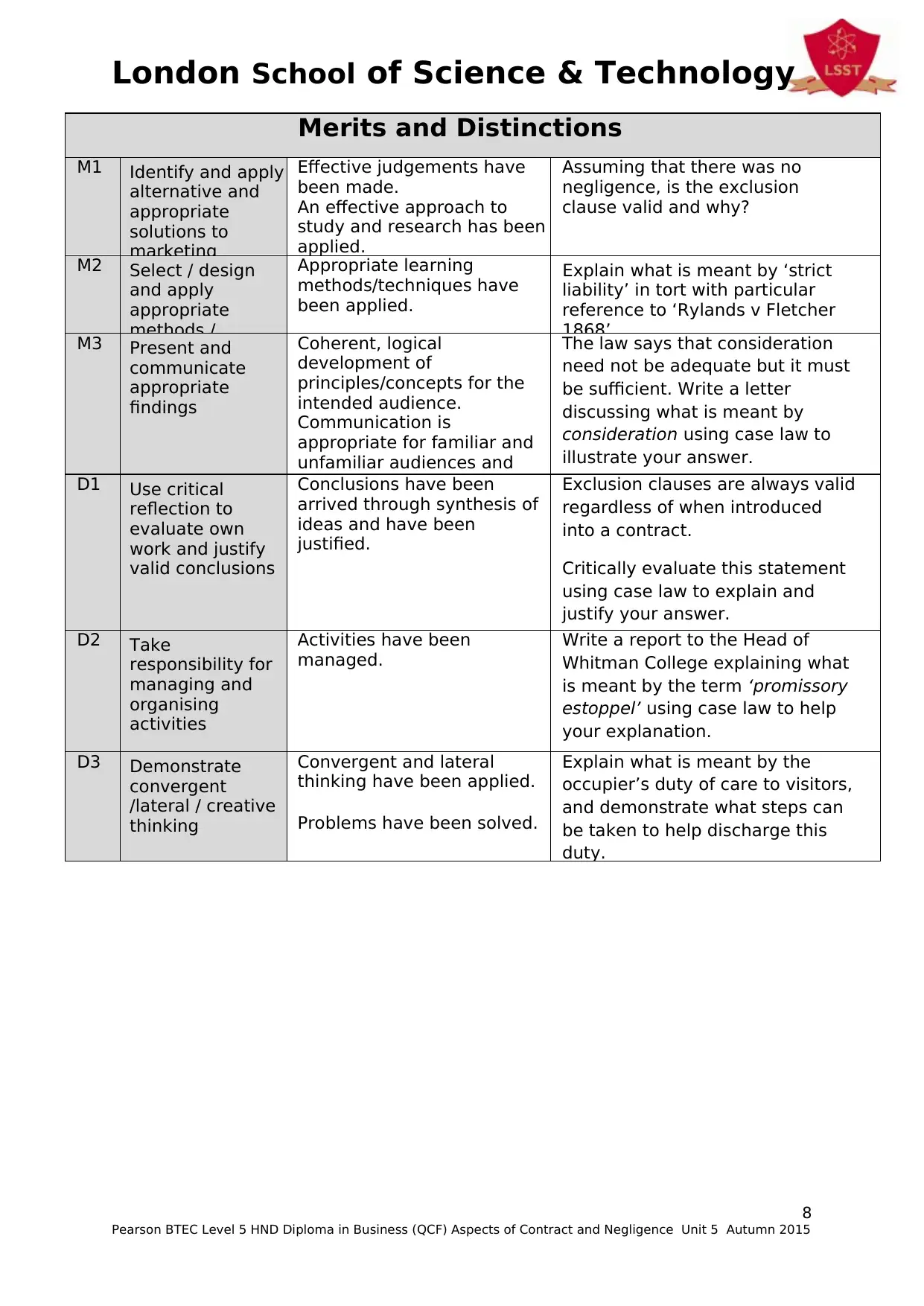
London School of Science & Technology
Merits and Distinctions
M1 Identify and apply
alternative and
appropriate
solutions to
marketing
Effective judgements have
been made.
An effective approach to
study and research has been
applied.
Assuming that there was no
negligence, is the exclusion
clause valid and why?
M2 Select / design
and apply
appropriate
methods /
Appropriate learning
methods/techniques have
been applied.
Explain what is meant by ‘strict
liability’ in tort with particular
reference to ‘Rylands v Fletcher
1868’.
M3 Present and
communicate
appropriate
findings
Coherent, logical
development of
principles/concepts for the
intended audience.
Communication is
appropriate for familiar and
unfamiliar audiences and
appropriate media have
The law says that consideration
need not be adequate but it must
be sufficient. Write a letter
discussing what is meant by
consideration using case law to
illustrate your answer.
D1 Use critical
reflection to
evaluate own
work and justify
valid conclusions
Conclusions have been
arrived through synthesis of
ideas and have been
justified.
Exclusion clauses are always valid
regardless of when introduced
into a contract.
Critically evaluate this statement
using case law to explain and
justify your answer.
D2 Take
responsibility for
managing and
organising
activities
Activities have been
managed.
Write a report to the Head of
Whitman College explaining what
is meant by the term ‘promissory
estoppel’ using case law to help
your explanation.
D3 Demonstrate
convergent
/lateral / creative
thinking
Convergent and lateral
thinking have been applied.
Problems have been solved.
Explain what is meant by the
occupier’s duty of care to visitors,
and demonstrate what steps can
be taken to help discharge this
duty.
8
Pearson BTEC Level 5 HND Diploma in Business (QCF) Aspects of Contract and Negligence Unit 5 Autumn 2015
Merits and Distinctions
M1 Identify and apply
alternative and
appropriate
solutions to
marketing
Effective judgements have
been made.
An effective approach to
study and research has been
applied.
Assuming that there was no
negligence, is the exclusion
clause valid and why?
M2 Select / design
and apply
appropriate
methods /
Appropriate learning
methods/techniques have
been applied.
Explain what is meant by ‘strict
liability’ in tort with particular
reference to ‘Rylands v Fletcher
1868’.
M3 Present and
communicate
appropriate
findings
Coherent, logical
development of
principles/concepts for the
intended audience.
Communication is
appropriate for familiar and
unfamiliar audiences and
appropriate media have
The law says that consideration
need not be adequate but it must
be sufficient. Write a letter
discussing what is meant by
consideration using case law to
illustrate your answer.
D1 Use critical
reflection to
evaluate own
work and justify
valid conclusions
Conclusions have been
arrived through synthesis of
ideas and have been
justified.
Exclusion clauses are always valid
regardless of when introduced
into a contract.
Critically evaluate this statement
using case law to explain and
justify your answer.
D2 Take
responsibility for
managing and
organising
activities
Activities have been
managed.
Write a report to the Head of
Whitman College explaining what
is meant by the term ‘promissory
estoppel’ using case law to help
your explanation.
D3 Demonstrate
convergent
/lateral / creative
thinking
Convergent and lateral
thinking have been applied.
Problems have been solved.
Explain what is meant by the
occupier’s duty of care to visitors,
and demonstrate what steps can
be taken to help discharge this
duty.
8
Pearson BTEC Level 5 HND Diploma in Business (QCF) Aspects of Contract and Negligence Unit 5 Autumn 2015
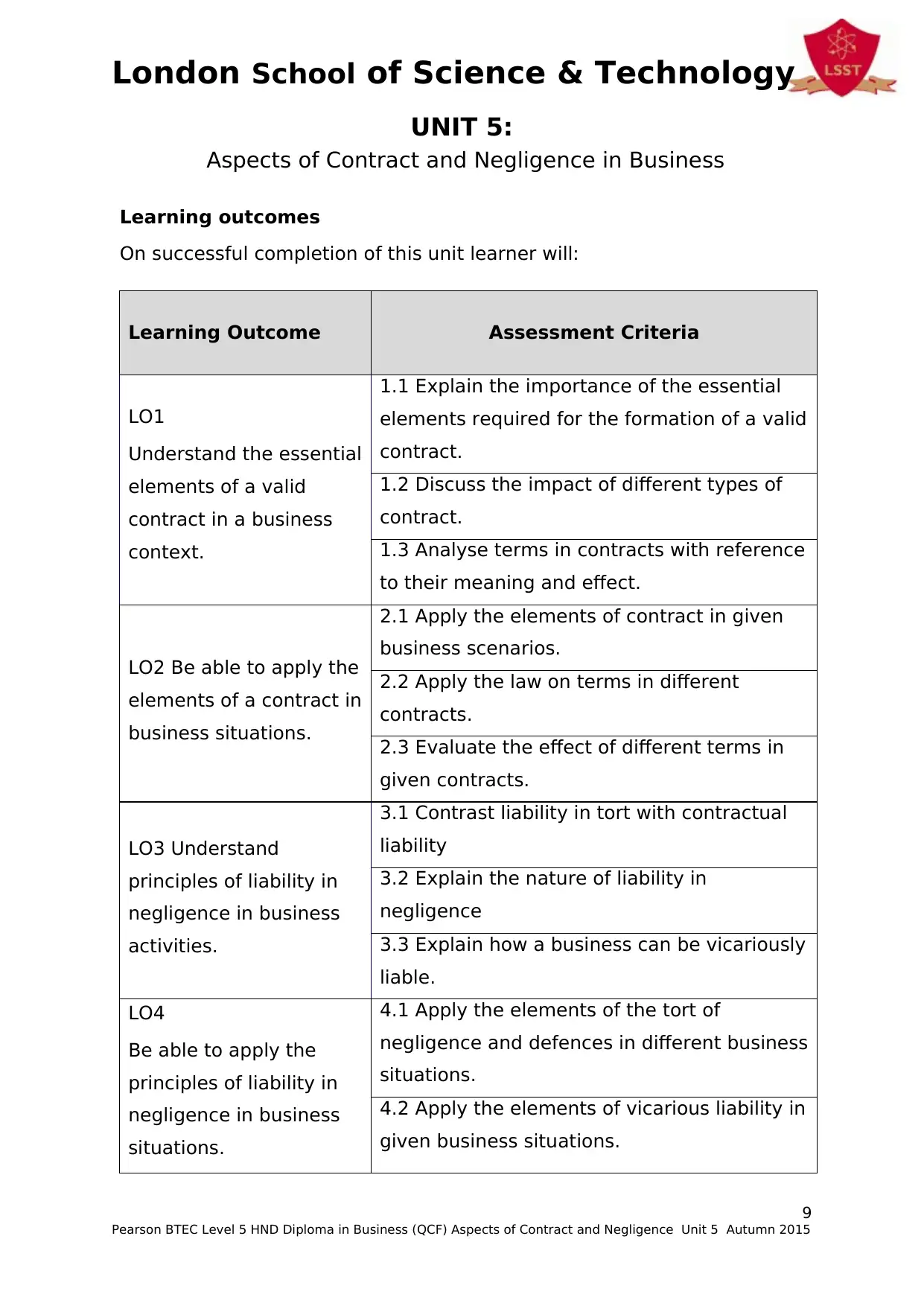
London School of Science & Technology
UNIT 5:
Aspects of Contract and Negligence in Business
Learning outcomes
On successful completion of this unit learner will:
Learning Outcome Assessment Criteria
LO1
Understand the essential
elements of a valid
contract in a business
context.
1.1 Explain the importance of the essential
elements required for the formation of a valid
contract.
1.2 Discuss the impact of different types of
contract.
1.3 Analyse terms in contracts with reference
to their meaning and effect.
LO2 Be able to apply the
elements of a contract in
business situations.
2.1 Apply the elements of contract in given
business scenarios.
2.2 Apply the law on terms in different
contracts.
2.3 Evaluate the effect of different terms in
given contracts.
LO3 Understand
principles of liability in
negligence in business
activities.
3.1 Contrast liability in tort with contractual
liability
3.2 Explain the nature of liability in
negligence
3.3 Explain how a business can be vicariously
liable.
LO4
Be able to apply the
principles of liability in
negligence in business
situations.
4.1 Apply the elements of the tort of
negligence and defences in different business
situations.
4.2 Apply the elements of vicarious liability in
given business situations.
9
Pearson BTEC Level 5 HND Diploma in Business (QCF) Aspects of Contract and Negligence Unit 5 Autumn 2015
UNIT 5:
Aspects of Contract and Negligence in Business
Learning outcomes
On successful completion of this unit learner will:
Learning Outcome Assessment Criteria
LO1
Understand the essential
elements of a valid
contract in a business
context.
1.1 Explain the importance of the essential
elements required for the formation of a valid
contract.
1.2 Discuss the impact of different types of
contract.
1.3 Analyse terms in contracts with reference
to their meaning and effect.
LO2 Be able to apply the
elements of a contract in
business situations.
2.1 Apply the elements of contract in given
business scenarios.
2.2 Apply the law on terms in different
contracts.
2.3 Evaluate the effect of different terms in
given contracts.
LO3 Understand
principles of liability in
negligence in business
activities.
3.1 Contrast liability in tort with contractual
liability
3.2 Explain the nature of liability in
negligence
3.3 Explain how a business can be vicariously
liable.
LO4
Be able to apply the
principles of liability in
negligence in business
situations.
4.1 Apply the elements of the tort of
negligence and defences in different business
situations.
4.2 Apply the elements of vicarious liability in
given business situations.
9
Pearson BTEC Level 5 HND Diploma in Business (QCF) Aspects of Contract and Negligence Unit 5 Autumn 2015
⊘ This is a preview!⊘
Do you want full access?
Subscribe today to unlock all pages.

Trusted by 1+ million students worldwide

London School of Science & Technology
UNIT 5:
Aspects of Contract and Negligence in Business
Reference Material - GUIDES TO RELEVANT CASES
Invitation to Treat
• Pharmaceutical Society of GB v Boots Cash Chemists [1953]
• Pharmacy and Poisons Act 1933
• Fisher v Bell [1961]
Advertisements
• Partridge v Crittenden [1968]
• Harvey v Facey [1893]
Not Invitation to Treat -Unilateral Offer
• Carlill v Carbolic Smoke Ball Company [1893]
• Biggs v Boyd Gibbins [1971]
Offer
• Carlill v Carbolic Smoke Ball Co [1893]
• Guthing v Lynn [1831]
• Routledge v Grant [1828]
Acceptance
• Felthouse v Bindley [1863]
• Yates v Pulleyn [1975]
Consideration
• Thomas v Thomas [1842]
• Ward v Byham [1956]
• Tweddle v Atkinson [1861]
• Collins v Godfrey [1831]
Promissory estoppel
• DC Builders v Rees [1965]
General rule of Privity of Contract
• Dunlop v Selfridge 1915
Bishop, W. (1982). "Economic loss in tort". Oxford Journal of Legal Studies.
Phillip G. Sharp ,“Bond Law Review”,( 2005) Vol 17 Issue 2, Article10,207.
Elliott,Paul (speaker),“Contract law review, Exemption Clause”( Business
Law Education Center)BLEC, seminar July 1995.
10
Pearson BTEC Level 5 HND Diploma in Business (QCF) Aspects of Contract and Negligence Unit 5 Autumn 2015
UNIT 5:
Aspects of Contract and Negligence in Business
Reference Material - GUIDES TO RELEVANT CASES
Invitation to Treat
• Pharmaceutical Society of GB v Boots Cash Chemists [1953]
• Pharmacy and Poisons Act 1933
• Fisher v Bell [1961]
Advertisements
• Partridge v Crittenden [1968]
• Harvey v Facey [1893]
Not Invitation to Treat -Unilateral Offer
• Carlill v Carbolic Smoke Ball Company [1893]
• Biggs v Boyd Gibbins [1971]
Offer
• Carlill v Carbolic Smoke Ball Co [1893]
• Guthing v Lynn [1831]
• Routledge v Grant [1828]
Acceptance
• Felthouse v Bindley [1863]
• Yates v Pulleyn [1975]
Consideration
• Thomas v Thomas [1842]
• Ward v Byham [1956]
• Tweddle v Atkinson [1861]
• Collins v Godfrey [1831]
Promissory estoppel
• DC Builders v Rees [1965]
General rule of Privity of Contract
• Dunlop v Selfridge 1915
Bishop, W. (1982). "Economic loss in tort". Oxford Journal of Legal Studies.
Phillip G. Sharp ,“Bond Law Review”,( 2005) Vol 17 Issue 2, Article10,207.
Elliott,Paul (speaker),“Contract law review, Exemption Clause”( Business
Law Education Center)BLEC, seminar July 1995.
10
Pearson BTEC Level 5 HND Diploma in Business (QCF) Aspects of Contract and Negligence Unit 5 Autumn 2015
Paraphrase This Document
Need a fresh take? Get an instant paraphrase of this document with our AI Paraphraser
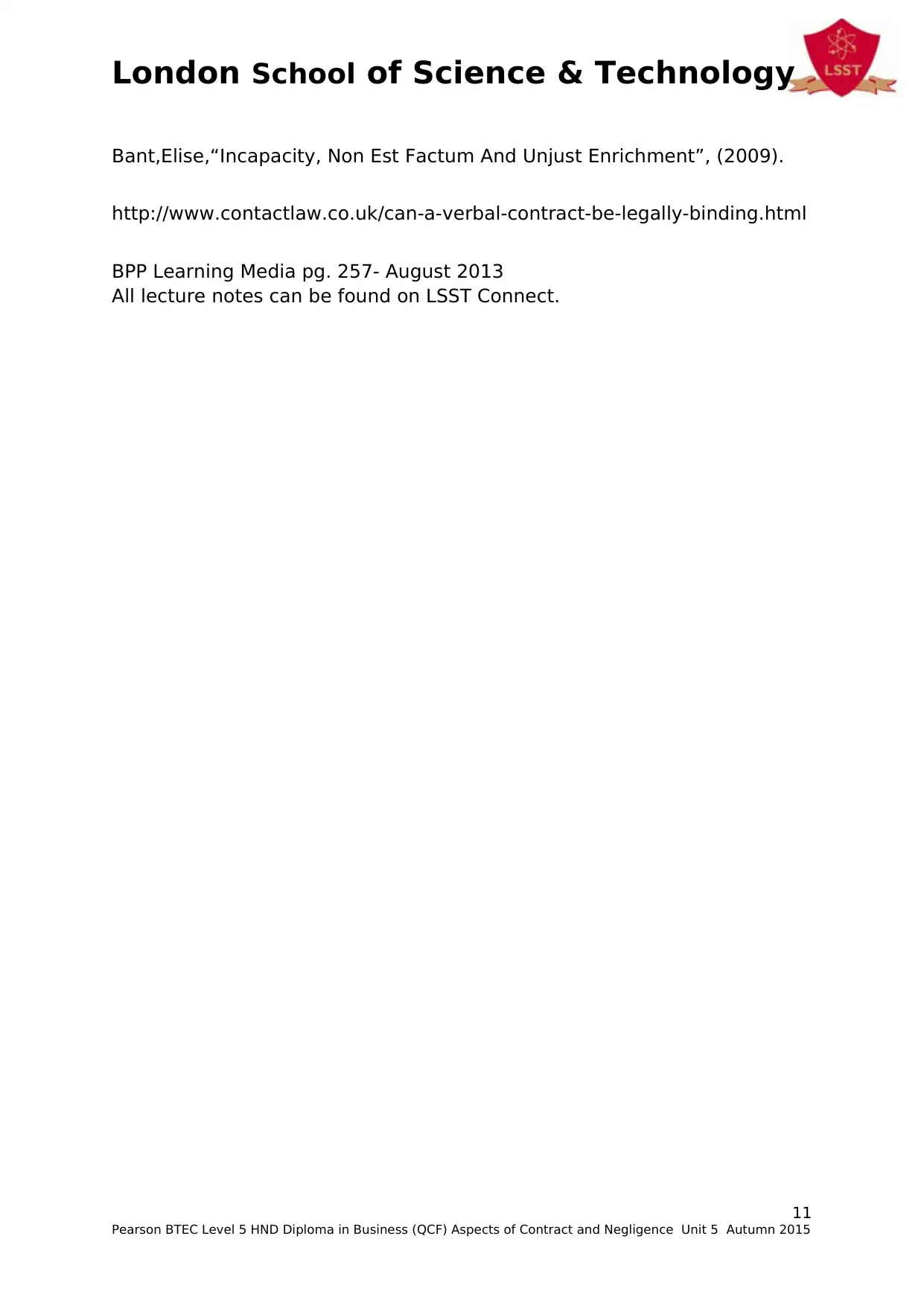
London School of Science & Technology
Bant,Elise,“Incapacity, Non Est Factum And Unjust Enrichment”, (2009).
http://www.contactlaw.co.uk/can-a-verbal-contract-be-legally-binding.html
BPP Learning Media pg. 257- August 2013
All lecture notes can be found on LSST Connect.
11
Pearson BTEC Level 5 HND Diploma in Business (QCF) Aspects of Contract and Negligence Unit 5 Autumn 2015
Bant,Elise,“Incapacity, Non Est Factum And Unjust Enrichment”, (2009).
http://www.contactlaw.co.uk/can-a-verbal-contract-be-legally-binding.html
BPP Learning Media pg. 257- August 2013
All lecture notes can be found on LSST Connect.
11
Pearson BTEC Level 5 HND Diploma in Business (QCF) Aspects of Contract and Negligence Unit 5 Autumn 2015
1 out of 11
Related Documents
Your All-in-One AI-Powered Toolkit for Academic Success.
+13062052269
info@desklib.com
Available 24*7 on WhatsApp / Email
![[object Object]](/_next/static/media/star-bottom.7253800d.svg)
Unlock your academic potential
Copyright © 2020–2025 A2Z Services. All Rights Reserved. Developed and managed by ZUCOL.





